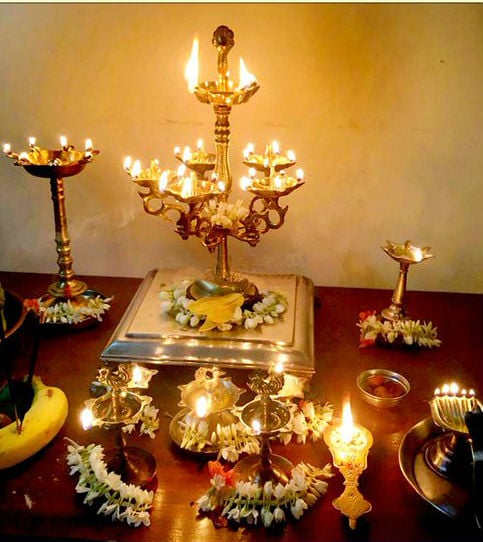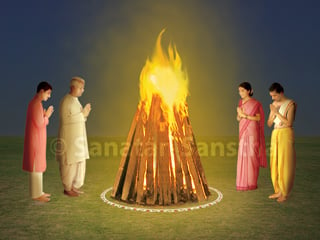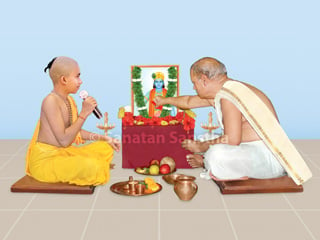
Deep Poojan (ritualistic worship of lamp) done on the day of Ashadha (fourth month of the Hindu lunar almanac) Amavasya (no moon day) or ‘Deepanvit Amavasya’ to express gratitude unto the Agni (Sacred Fire Principle) !
Deep Poojan is done on the day of Ashadha Amavasya
1. The science behind performing the Deep Poojan
The flame of an ignited lamp (oil/ghee lamp) signifies the sacred Fire principle. Deep Poojan is done on Ashadha Amavasya to express gratitude unto the Agni.
2. The importance of Sacred Fire
Principle amongst the five Cosmic Principles.
All the living-non living objects have been developed due the five Cosmic Principles namely the earth, water, fire, air and void (akash). Amongst these five cosmic principles, the importance of Fire principle is unique. The virtue of fire is its ‘roop’ (form/appearance). Due to the fire principle we are able to visualize an object (its form). Eyes which are one of the five senses, are related to the Sacred Fire Principle. Agni with its light destroys the darkness and enlightens us with the truth. Agni governs the body of humans and animals by being omni present in their body and thus helps in digestion of food. Sun a form of the Agni is the main planet of the solar system and is responsible for the well being of the entire universe.
In the vedic era, Agni Deity had the highest seat of worship. In rigveda, Agni is given the adjective as ‘Hota’. ‘Hota’ means a medium to invoke Deity or Energy ! After invoking the particular Deities in a yadnya (Sacrificial Fire), The Fire in it conveys the offerings made in the yadnya to the Deities. Thus, Fire Principle is considered as a bond connecting the Humans and the Deities., (Reference ; Bharatiya Sanskrutikosh, Khanda 1, page 78)
3. Deepaanvit Amavasya
Ashadha Amavasya is also called as Deepaanvit Amavasya. On this day the ritualistic worship of lamps (deep) is done. The married women gather all the lamps in the house and clean them thoroughly and place them together. A rangoli is drawn around them. Then these lamps are lit and their ritualistic worship is done. An offering of various delicacies is made to these lamps and then prayer is offered unto the lamps by reciting the below mantra.
दीप सूर्याग्निरूपस्त्वं तेजसां तेज उत्तमम् ।
गृहाण मत्कृतां पूजां सर्वकामप्रदो भव ॥
Meaning : O lamp, ‘You are the form of Sun and Fire. Amongst all the glow, you have the best radiance. Please accept my ritualistic worship and fulfill all my wishes.”
After this the story of the lamp is heard. By performing this ritualistic worship, one gets healthy and long life as well as wealth. (reference : Bhaktikosh, fourth khanda, page 877)
– Mr. Raj karve, Jyotish expert, Phonda, Goa.
4. Spiritual benefits of performing ritualistic worship of the lamp.
4 A. Performing ritualistic worship of lamps on the day of Ashadha
Amavasya, the lamps are enriched with Taj-tattva (Absolute Fire Principle) rich
Sattvikta and Chaitanya and thus are protected from the attack of negative energies.
The Deities are inactive during the chaturmas period and hence the percentage of Raja-Tama waves and the dominance of the negative energies in the atmosphere increases. Also, due to the rainy and cloudy atmosphere, the sun rays reaching the earth is very low. This way, during the chaturmas period, there is insufficiency of Sattvikta, Chaitanya and the tej-tattva. Compared to other days in a fortnight, on the days of Poornima(full moon day) and Amavasya the power of negative energies increases and they attack the sattvik elements through the subtle on a large scale. The attack of negative energies too is on large scale on the Ashadha amavasya in the chaturmas period. Hence it is of great significance of doing ritualistic worship of the lamps on the day of Ashadh Amavasya. By doing so, the lamps are enriched with Taj-tattva rich sattvikta and chaitanya and are thus protected from the attack of negative energies.
4 B. The subtle covering around the lamp due the Raja-Tama waves
and the distressing energies in the atmosphere is decimated by the Deep Poojan.
The subtle covering developed around the lamp due to the Raja-Tama waves and the distressing energies which are active in the atmosphere around the lamp is wiped off by the ritualistic worship of the lamp. Hence when the lamp is lighted, its flame appears clean, clear and prominent. The flame remains stable and looks absolutely clear. Also their is reduction in the soot formation on the wick of the lamp.
4 C. Due to the worship of the God principle in the lamp,
the God Principle is awakened and it remains active throughout the year
Due to the worship of the God principle in the lamp, the God Principle is awakened and it remains active throughout the year. Joining of palms of hands in the namaskar posture towards the lamp on their own after seeing the flame, awakening of spiritual emotion after seeing the lamp, experiencing that the illumination of the lamp has become more radiant and enriched with chaitanya are all signs and spiritual experiences of the God principle being awakened in the lamp.
4 D. Formation of impermeable protective sheath of
absolute fire principle of Agninarayan around the lamp and thus the
lamp getting protected from the attack of negative energies through out the year
After the ritualistic worship of the lamp, it regains the energy after receiving the radiance from the Agninarayan. This energy helps the lamp to continue its spiritual practice (sattvikta) continually. Formation of impermeable protective sheath of absolute fire principle of Agninarayan around the lamp and thus the lamp getting protected from the attack of negative energies through out the year.
4 E. Doing the ritualistic worship of the lamp increases its strength to
fight the subtle battle with the negative energies which persists through out the year
Doing the ritualistic worship of lamp, provides it with protective sheath of Agninarayan which increases its kshatratej (radiance of kshatriya [warrior]). Thus the lamp’s capacity to fight the attacks from negative energies increases and its strength to fight subtle battle with the negative energies also increases, which remains persistent through out the year.
4 F. The one performing the ritualistic worship of the lamp
receives blessings from the lamp signifying a devotee and the God
Lamp is God’s devotee having the spiritual emotion of service unto the truth (sevak bhav). By doing ritualistic worship of a devotee, the devotee gets bliss and even the God is pleased and the one performing the ritualistic worship of the lamp receives blessings from both the lamp as well as the God which helps in progress of his spiritual practice.
4 G. The one performing the Deep Poojan in reality does a
samashti spiritual practice (spiritual practice for the spread of spirituality).
By doing the ritualistic worship of the lamp, it helps the lamp to perform its spiritual practice. Thus the one performing the ritualistic worship of the lamp also benefits by doing this Samashti spiritual practice.
5. Sinning by interrupting the spiritual practice of the lamp
by touching the ignited lamp and taking atonement for the same.
The spiritual practice of the lamp is ongoing. Thus touching it causes hurdles in its spiritual practice. Also due to our touching the lamp emitts Raja-Tama waves towards the lamp which can cause a sheath of distressing energies around it. Hence, as per Hindu Dharmashastra, it is a sin to touch the lamp. In case we mistakenly touch the lamp, then we should wash the hands with clean water and by standing in front of the lamp with hands folded in namskar posture should ask for forgiveness from the lamp. By doing this the person becomes free from his sin of touching the lamp.
(It is not right to touch the lamp repeatedly after igniting it. None of the rituals mentions touching the lamp once it is ignited – Vedmurti Ketan Shahane)
6. Ritualistic worship of lamp and ‘Deep Yadnya’
Performing ritualistic worship of lamp falls under the samashti spiritual practice. By doing ritualistic worship of multiple lamps is an act of doing samashti spiritual practice and hence it is called as ‘Deep Yadnya’. It is a ritual to perform Deep Yadnya in the month of Ashadha.
– Ms. Madhura Bhosale, shravan krushna dwitiya, Kaliyug, year 5113

 Holi / Holika Dahan 2024
Holi / Holika Dahan 2024 Shrikrishna Janmashtami Pooja (along with mantras and their meaning)
Shrikrishna Janmashtami Pooja (along with mantras and their meaning) Akshay Trutiya 2023
Akshay Trutiya 2023 Tripurari Poornima (Kartik Poornima)
Tripurari Poornima (Kartik Poornima) Message from Shrichitshakti (Mrs) Anjali Mukul Gadgil and Shrisatshakti (Mrs) Binda Singbal on the occasion...
Message from Shrichitshakti (Mrs) Anjali Mukul Gadgil and Shrisatshakti (Mrs) Binda Singbal on the occasion... Paratpar Guru (Dr) Athavale’s message for Gurupurnima (2022)
Paratpar Guru (Dr) Athavale’s message for Gurupurnima (2022)